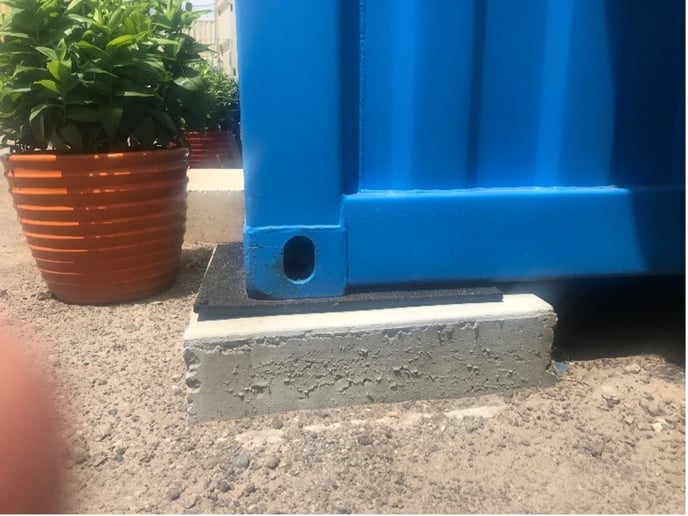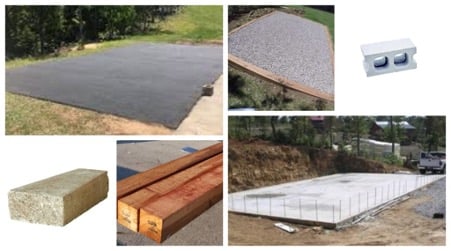How to place your storage container on-site
Container placement is very important to preserving the functionality & maximizing the lifespan of your new container.
Preparing the site
Congrats on your new container from Eveon. Before the delivery there are a few steps we recommend to insure your delivery is seamless and easy. Let's get started...
First and foremost, we recommend that you prepare your property and the ground for your Eveon container. You want a level area at least as big as your (20ft or 40ft) container and access for our delivery truck. This area should be free from debris and and mud. If it has rained a lot around your delivery window you may even want to contact your driver to schedule for another day. A soft ground can make delivery more difficult on your driver.
Also if the ground is too soft the container can sink once it has been put into place. Storage containers don’t necessarily need a concrete base to sit on, but this is a great option if available, especially if the ground is unstable or tends to get wet.
Double check there are no overhead obstructions such as tree branches, phone or power cables that might obstruct the lifting process. The top of the crane on the truck can easily sit 25-30ft from the ground. Please note, the driver has the option to refuse delivery if the conditions could cause damage to your home or the truck.
If you are in any doubt over the access, we recommend sending us (or the driver) some photos or perhaps even a video walkthrough of the site so that we (or the driver) is aware of any challenges. In the case of delivery, it is always better to be safe.
Couple of other items to consider:
Which way the doors are going to face? Make sure you have enough room to open the doors to get in and out. We suggest walking the area and clearly understanding the footprint of 20-40ft on your property. Sharing how you want to enter the container is a detail you will need to share with the driver.
Do you need to raise the container off the ground? Each container has clearance on the bottom so the container does not actually sit on the ground. However, if you are putting the container in mud or on dirt, we recommend that the shipping container is raised up slightly from the ground to allow an airflow underneath. This will prolong the life of the underside of the container.
Is your container level? Shipping containers need to be kept level. If they aren’t level you may find the doors become very stiff or unworkable. Containers are designed to flex slightly at sea on a shipping vessel. This means if you place a shipping container on uneven ground the container itself might flex to one side, making your doors harder or impossible to closer properly. Railroad ties, concrete slabs and removing debris can help to make sure your doors work properly. As big and as strong as containers are, they are sensitive to shifting on uneven ground.
Footings
A container can sit directly on level ground, however we do not recommend this, since no ventilation is possible between container floor and ground. This might result in condensation in the container and if worst, molt and decading floorboards. Better to place the container on footings to keep the container off the ground. You can use wooden beams, poured concrete footings or a concrete slab. Wooden Beam Footings (for example second hand railway ties) are the most affordable & easiest option available. We recommend when using wooden beam footings, a gravel bed should be made underneath the wood to aid in drainage – keeping the beams dry and thus preventing premature rotting of the wood. Concrete footings are ideal when the container is going to be located in the same place for a long time. You can form up concrete in each corner at exactly the same level and have the container unloaded on top of the footings. We recommend that a bit of rubber is placed between the concrete and the container as per photo.


Double check to make sure there are no overhead obstructions such as tree branches, phone or power cables that might obstruct the lifting process. This is not only above the area your container will sit but also above the area the truck will access for delivery. If you are in any doubt over the access we recommend sending us (or your driver) some photos or a video of the site, so we can best understand the challenges that we may address during delivery.
Make sure your supports will be able to take the weight of the container plus the weight of your cargo without any risk of moving or settling.
- Pairs of bricks, cinder blocks
- heavy duty paving slabs or cement blocks
- 4×4, 8×8, railroad ties are common supports used
- gravel pad – is recommended and allows drainage and airflow underneath the unit
- cement or tarmac pad – also recommended and can be combined with first tree options as well
- On YouTube you can find several videos on how to level your container
Planning On Building Out The Containers?
If you are planning on supplying the unit with electricity, water or internet connectivity, you will also need to take this into account. You will need to consider planning and permitting (based on your city).
We recommend that you check with your local city building and planning departments if you have any doubts relating to your project.
It is important that you carefully consider exactly where you place them. Not only for them to be fully functional, effective and long-lasting for their specific uses, but also to ensure compliance, safety and security.